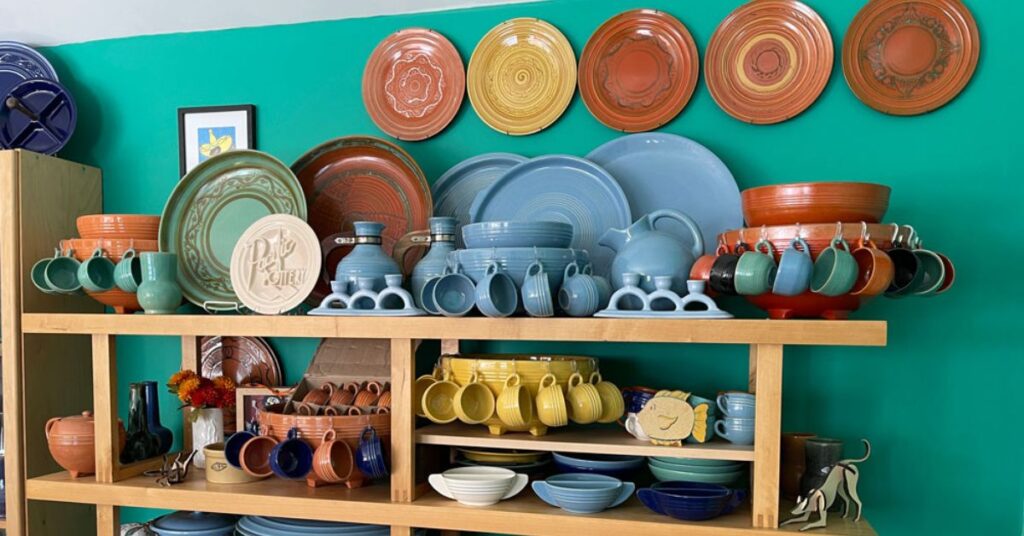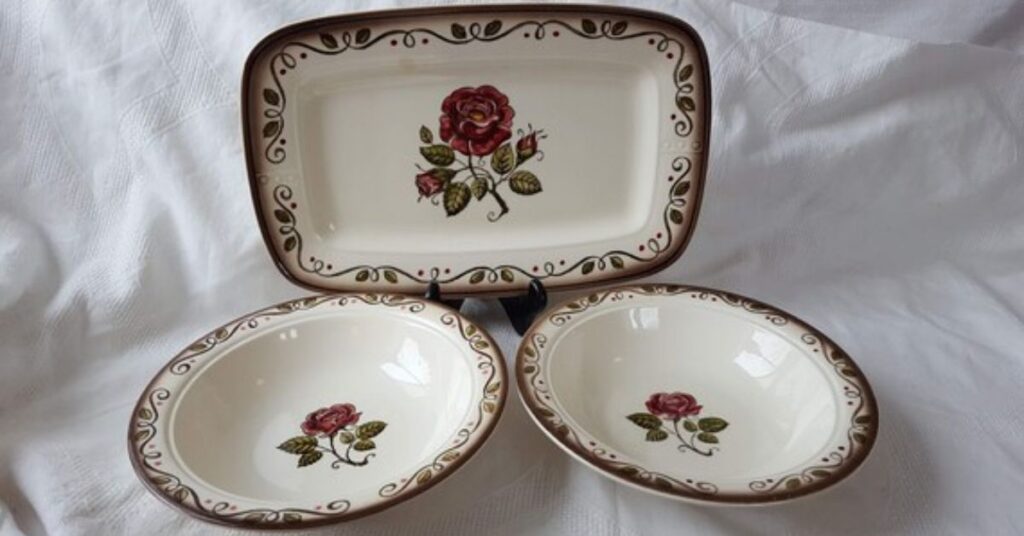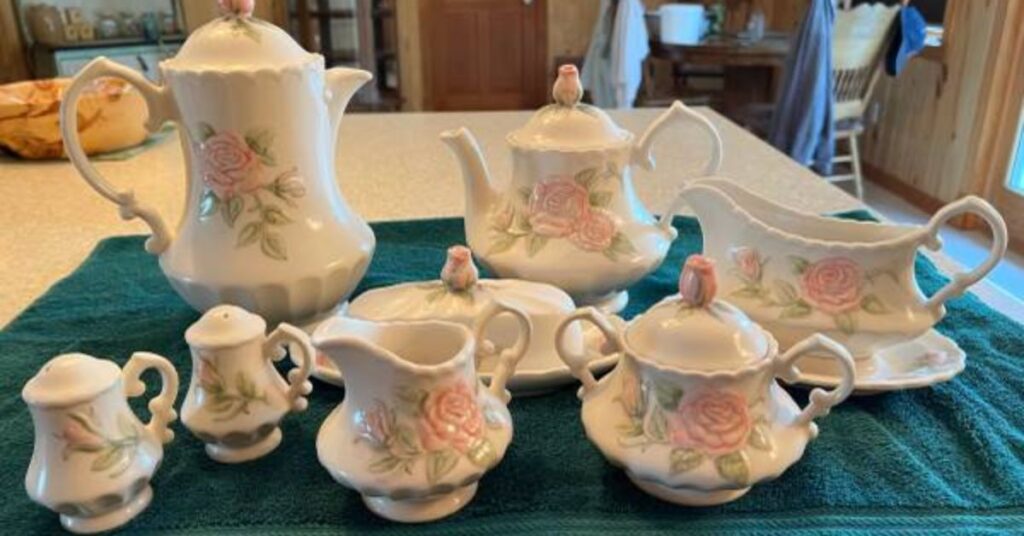The History of Metlox Dining California Rose Pattern Vernon Ware is a captivating tale of mid-century American ceramics. This iconic pattern, featuring delicate pink roses on a creamy background, became a symbol of elegance and casual charm in countless households during the 1950s and 60s.
Metlox Pottery, founded in 1927 in Manhattan Beach, California, created the California Rose pattern as part of its Vernon Ware line. The pattern’s enduring popularity reflects not only its aesthetic appeal but also its role in capturing the essence of post-war American optimism and the California lifestyle.
The Origins of Metlox Pottery
Metlox Pottery began its journey in 1927. T.C. Prouty founded the company in Manhattan Beach, California. The name “Metlox” came from a combination of “metal” and “oxide”. Initially, Metlox focused on producing ceramic signs. These signs were popular for outdoor use. In the early 1930s, the company shifted its focus to pottery. This move would shape its future for decades to come.
Metlox quickly gained recognition for its colorful designs. The company’s dinnerware stood out in the market. Bold glazes and unique patterns became their trademark. Metlox captured the essence of California living in its creations. The sunny, carefree lifestyle of the West Coast inspired their designs.
Early California Glazes
Early California glazes set Metlox apart. These glazes were vibrant and eye-catching. They reflected the bright California sunshine. Metlox experimented with various color combinations. This experimentation led to the creation of distinctive patterns. The glazes were often hand-applied, giving each piece a unique touch.
Metlox’s early success with glazes paved the way for future innovations. The company continued to develop new techniques. These advancements kept Metlox at the forefront of ceramic design. The early California glazes became a signature element of Metlox pottery.
The California Rose Pattern: A Mid-Century Icon
The California Rose pattern emerged in the 1950s. It quickly became one of Metlox’s most beloved designs. The pattern featured delicate pink roses. Green leaves complemented the floral motif. A creamy white background provided the perfect canvas for the design.
California Rose captured the essence of mid-century America. It blended elegance with casual charm. The pattern adorned various dinnerware pieces. From plates to serving bowls, California Rose graced many tables. Its popularity soared throughout the 1950s and 1960s.
The design of California Rose was versatile. It could be dressed up for special occasions. Yet, it was comfortable enough for everyday use. This versatility contributed to its widespread appeal. Families cherished their California Rose sets. The pattern became a staple in many American homes.
Shared Shapes
Metlox utilized shared shapes across different patterns. This approach was both practical and creative. The California Rose design adorned various forms. These forms were often shared with other popular Metlox lines. This strategy allowed for efficient production. It also gave consumers the ability to mix and match pieces.
Shared shapes included:
- Dinner plates
- Salad plates
- Soup bowls
- Teacups and saucers
- Serving platters
These common shapes made the California Rose pattern part of a larger Metlox family. Collectors could easily combine pieces from different sets. This flexibility added to the pattern’s enduring popularity.
Read As:Narissa Thelo fitness talk.net: A Guide to Achieving Optimal Fitness
Vernon Ware: More than Just Dinnerware
Vernon Ware was a division of Metlox Pottery. It produced high-quality dinnerware and kitchenware. The California Rose pattern was part of the Vernon Ware line. Vernon Ware became known for its durable, attractive designs. The line offered a wide range of patterns and styles.
Vernon Ware’s success contributed significantly to Metlox’s growth. The division produced both everyday and fine dining pieces. Vernon Ware items were found in homes across America. The brand became synonymous with quality and style.
Pacific Pottery
Pacific Pottery was another notable California pottery maker. It operated in the same era as Metlox. Pacific Pottery’s designs often complemented Metlox pieces. Some collectors mix Pacific Pottery with Metlox in their displays. The two companies shared a similar aesthetic. Both captured the spirit of California in their work.
Bauer Pottery
Bauer Pottery was a contemporary of Metlox. It was known for its colorful kitchenware. Bauer’s designs often featured bold, solid colors. While different from Metlox’s patterns, Bauer pieces could complement California Rose settings. The two companies represented different aspects of California pottery design.
Colorware
Colorware was a line produced by Metlox. It featured solid-colored pieces. These items could be mixed with patterned designs like California Rose. Colorware added versatility to Metlox collections. It allowed customers to create unique table settings. The line’s popularity showed Metlox’s ability to adapt to changing tastes.
Vernon Kilns
Vernon Kilns was a separate company from Metlox. However, it played a role in Metlox’s history. Metlox acquired some of Vernon Kilns’ molds and patterns. This acquisition expanded Metlox’s offerings. It also influenced the development of new designs. The connection between Vernon Kilns and Metlox added depth to the company’s portfolio.
Catalina Island Pottery
Catalina Island Pottery was known for its distinctive glazes. While not directly related to Metlox, it was part of the California pottery scene. Catalina’s pieces often featured rich, deep colors. These colors contrasted with Metlox’s lighter, more delicate patterns. Catalina Island Pottery represents another facet of California’s ceramic heritage.
Garden City Pottery
Garden City Pottery operated in San Jose, California. It produced both art pottery and functional ware. Garden City’s designs sometimes resembled Metlox patterns. The company was part of the broader California pottery movement. Its existence alongside Metlox shows the richness of California’s ceramic industry.
Gladding-McBean
Gladding-McBean was a large ceramics manufacturer. It produced both industrial and decorative items. The company’s Franciscan dinnerware line competed with Metlox. Gladding-McBean’s success paralleled that of Metlox. Both companies contributed to California’s reputation for quality ceramics.
Metlox
Metlox continued to innovate throughout its history. The company introduced new lines and patterns. It adapted to changing consumer preferences. Metlox’s ability to evolve kept it relevant for decades. The California Rose pattern remained a constant favorite throughout these changes.
Meyers California Rainbow
Meyers California Rainbow was another pottery company. It operated in California during Metlox’s heyday. Meyers produced colorful tableware. Its designs often featured bright, cheerful colors. While different from Metlox’s style, Meyers represented another aspect of California pottery design.
The Decline and Revival of Metlox

Metlox faced challenges in the late 20th century. Changing consumer tastes affected sales. Competition from overseas manufacturers increased. The company struggled to adapt to these new market conditions. In 1989, Metlox closed its doors. This closure marked the end of an era in California pottery.
However, Metlox’s legacy lived on. Collectors continued to cherish Metlox pieces. The California Rose pattern remained highly sought after. Vintage Metlox items became prized possessions. The closure of the company only increased interest in its products.
In recent years, there has been a revival of interest in mid-century design. This trend has brought renewed attention to Metlox pottery. The California Rose pattern has experienced a resurgence in popularity. New generations are discovering the charm of Metlox designs. This revival ensures that Metlox’s legacy continues to thrive.
Why Collect Metlox California Rose Pattern?

Collecting Metlox California Rose pattern offers many benefits. Here are some reasons why people collect these pieces:
- Historical value: California Rose represents a significant period in American design.
- Aesthetic appeal: The pattern’s delicate floral motif is timeless and beautiful.
- Versatility: Pieces can be used for display or everyday dining.
- Durability: Metlox pottery is known for its quality and longevity.
- Investment potential: Some rare pieces have increased in value over time.
Collectors often start with a few pieces and gradually expand their collections. They might focus on specific items or try to assemble complete sets. The hunt for rare or unusual pieces adds excitement to collecting. Many collectors enjoy sharing their passion with others who appreciate vintage pottery.
Conclusion
The history of Metlox Dining California Rose Pattern Vernon Ware is rich and fascinating. It spans decades of American cultural history. From its origins in 1927 to its closure in 1989, Metlox left an indelible mark on the world of ceramics. The California Rose pattern remains an iconic representation of mid-century design.
Metlox’s legacy extends beyond its products. It encompasses the broader story of California pottery. The company’s influence can be seen in the work of contemporaries and successors. Today, collectors and enthusiasts keep the spirit of Metlox alive. They preserve and celebrate these beautiful pieces of Americana.
Frequently Asked Questions
What years was the California Rose pattern produced?
The California Rose pattern was introduced in the 1950s and produced until Metlox’s closure in 1989.
How can I identify authentic Metlox California Rose pieces?
Look for the Metlox or Vernon Ware backstamp on the bottom of the piece. The pattern should feature hand-painted pink roses with green leaves.
Are Metlox California Rose pieces safe for everyday use?
Most pieces are safe for use, but it’s best to hand wash them to preserve the pattern and avoid potential lead concerns with older glazes.
What are some rare California Rose pieces?
Certain serving pieces, like gravy boats or large platters, are considered rare and valuable to collectors.
Can I still buy new Metlox California Rose pattern items?
No new pieces are being produced. All available items are vintage, found through antique stores, online marketplaces, or estate sales.









